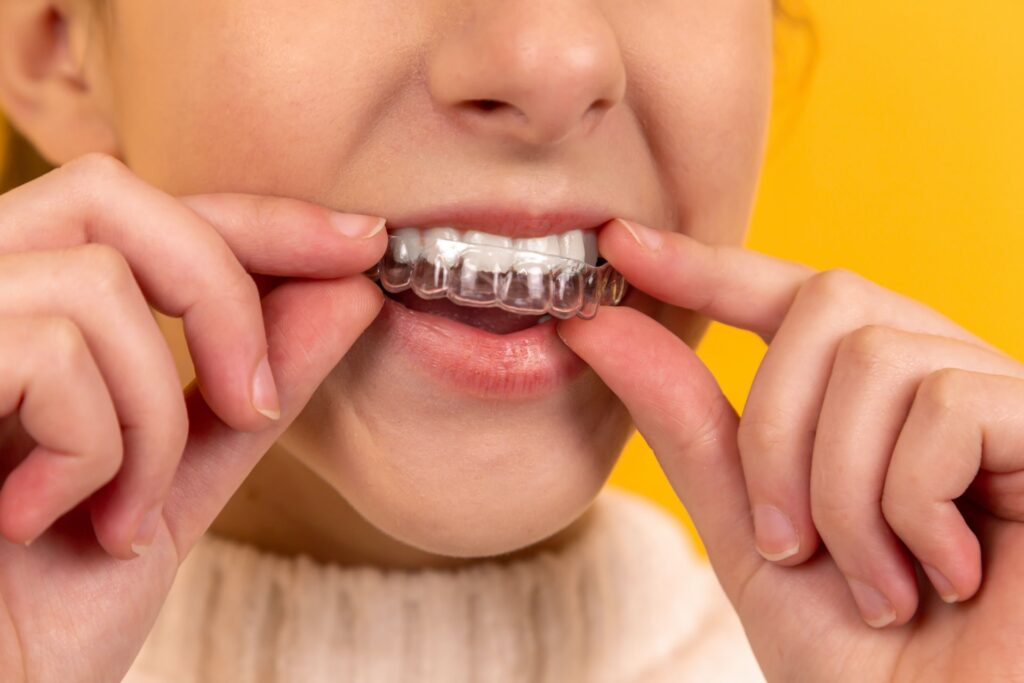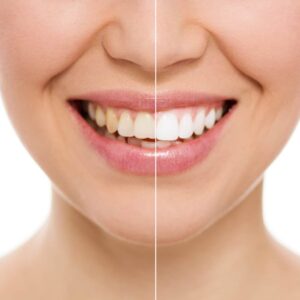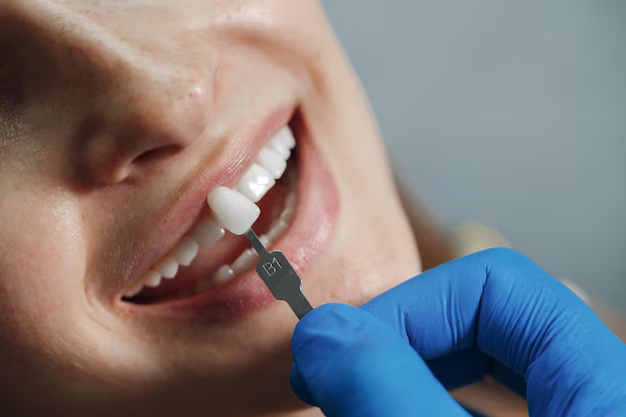Invisalign has emerged as a popular alternative to traditional braces, offering a more aesthetically pleasing and convenient option for teeth straightening. However, discomfort is a common experience, especially for new Invisalign users. This blog post is dedicated to helping you navigate these initial challenges, offering practical advice for first-time Invisalign users to manage and overcome any discomfort you may experience.
Invisalign discomfort can manifest in various forms – from mild irritation to more pronounced pain. But don’t worry – this is a normal part of the process. The discomfort is usually temporary and can be managed effectively with the right strategies. In this guide, we will provide you with essential tips on dealing with Invisalign discomfort, ensuring that your journey to a perfect smile is as comfortable as possible. Stay tuned for actionable Invisalign comfort tips, solutions for discomfort, and tips for Invisalign beginners to ease any discomfort you may encounter along the way.

Understanding Invisalign
Invisalign is a modern solution to teeth alignment that offers an alternative to traditional metal braces. This innovative dental technology involves the use of clear, removable aligners that are custom-designed for each individual. The aligners are changed every two weeks and work gradually to move your teeth into the desired position.
As a new Invisalign user, you may experience some discomfort or pain, particularly in the early stages of your treatment. This is normal and is usually a sign that the aligners are working as they should, applying pressure to your teeth to move them into place. There are many tips for handling Invisalign discomfort that can help you manage this aspect of the treatment. For instance, the aligners can be taken out for a couple of hours each day, which can help ease the pain. Also, it is recommended to change to a new set of aligners before bedtime to give your mouth time to adjust while you sleep.
The user guide provided by your orthodontist is a valuable resource for understanding how to use Invisalign effectively and cope with any discomfort that may arise. It contains advice for first-time Invisalign users, including tips for easing discomfort and strategies for overcoming any issues you might encounter.
Invisalign comfort tips can make your journey much smoother and more comfortable. Remember, the discomfort is temporary, but the benefits of a straight and healthy smile are permanent.
Common Discomforts Experienced by New Invisalign Users
As one embarks on their journey with Invisalign, it’s not uncommon to experience some discomfort. This discomfort can seem daunting for new Invisalign wearers, but with the right tips and advice, it can be managed effectively. This section will offer insights on the common discomforts experienced by individuals when they first start using Invisalign and provide tips on how to cope with them.
Handling Invisalign discomfort: For first-time Invisalign users, the initial discomfort can come as a surprise. However, this is a normal part of the process, and there are many ways to manage it. Over-the-counter pain relievers can be a great help during the first few days of wearing your aligners.
Coping with Invisalign pain: Some users may experience a sensation that feels more like pain, particularly when switching to a new aligner. Using a cold compress on the outside of your mouth can help to numb the area and reduce swelling, providing relief from the discomfort.
Easing Invisalign discomfort: It’s essential to remember that discomfort is temporary. Ensuring your aligners are clean and fitting correctly can help to minimize discomfort. Additionally, a soft diet can be beneficial during the first few days of each new aligner.
Overcoming discomfort from Invisalign: Invisalign discomfort solutions involve patience and care. Always remember to remove your aligners when eating or drinking anything other than water. This not only helps keep your aligners clean but also reduces the chance of them becoming discolored or damaged.
Invisalign comfort tips: Lastly, maintaining good oral hygiene can also contribute to a more comfortable Invisalign experience. Brushing and flossing your teeth regularly, and cleaning your aligners daily, can help to prevent irritation and discomfort.
Managing Initial Discomfort: Tips and Tricks
The first few days of wearing Invisalign aligners can be a bit of a challenge due to the discomfort they may cause. But don’t worry, this discomfort is completely normal and is a sign that your aligners are working – they’re moving your teeth to their ideal positions. The good news is that there are practical ways to manage this discomfort.
One of the most effective methods for easing Invisalign discomfort is the use of over-the-counter pain relievers. Before your aligners arrive, make sure to have a pack of your preferred pain reliever handy. Take these as directed when you begin to feel discomfort. Remember, it’s essential to take them only as necessary and to always follow the instructions on the packaging.
Rinsing your mouth with warm salt water can also provide relief. This remedy has been used for ages to soothe oral discomfort, and it’s just as effective for new Invisalign users. Mix half a teaspoon of salt in one cup of warm water. Swish this solution around your mouth for about 30 seconds and spit it out. Repeat this a few times a day as needed.
Here are some additional tips to help you cope with the initial discomfort:
Invisalign User Guide: Make sure to read and understand the user guide provided by your orthodontist. It contains essential tips and advice to help you manage discomfort and use your aligners effectively.
Handling Invisalign Discomfort: It’s essential to remember that the discomfort you’re feeling is a sign that your Invisalign treatment is working. Stay positive and patient as your mouth adjusts to the new aligners.
Tips for New Invisalign Wearers: Listen to the experiences of others who have gone through the same process. They can provide invaluable advice and reassurance that can help you navigate the initial stages of your Invisalign journey.
Coping with Invisalign Pain: Keep in mind that the pain will subside after a few days. In the meantime, stick to soft foods to avoid additional discomfort.
Invisalign Comfort Tips: Make sure to remove your aligners while eating and drinking anything other than water. This will help prevent damage to your aligners and teeth.
Remember, the initial discomfort will pass, and soon you’ll be comfortable wearing your aligners. The key is to remain patient and persistent. After all, the result will be a beautiful, straight smile!
“New Invisalign users often experience a slight discomfort at the beginning, which is a sign that the aligners are working as intended. Patience, persistence, and a good oral care routine can significantly ease this transition phase. Remember, every moment of discomfort is a step closer to achieving the smile you’ve always desired.”
– Dr. Guneet Alag, DDS, FAGD, Fab Dental, Hayward, CA.
Timeframe of Discomfort: What to Expect
As a new Invisalign user, it’s perfectly normal to experience some discomfort or even a bit of pain in the early stages of treatment. This is a common part of the journey towards a more beautiful and confident smile. But, how long does this discomfort last? And what can you do to manage it? In this section, we’ll shed some light on these questions and offer some practical tips for handling Invisalign discomfort.
In the first few days after you start wearing your Invisalign trays, you might feel some tightness or pressure in your mouth. This is because your teeth are beginning to adjust to their new positions. Most Invisalign wearers report that this discomfort fades after the first week. However, it might return briefly each time you switch to a new set of aligners, as your teeth continue their gradual shift. But don’t worry, this is a sign that your treatment is working, and the discomfort will decrease over time.
To manage this discomfort, there are several strategies that can help. First, try to wear your Invisalign aligners as much as possible. The more you wear them, the faster your mouth will adjust. Second, avoid eating hard or crunchy foods, especially in the first few days. Instead, opt for softer foods that are easier on your teeth. Finally, over-the-counter pain relievers can be helpful in easing any discomfort. Remember, the discomfort is temporary and is a part of the process towards achieving the smile you’ve always wanted.
In the end, dealing with the initial discomfort is a small price to pay for the fantastic results Invisalign offers. So hang in there, follow these tips, and before you know it, you’ll be flashing a confident and beautiful smile.
What To Do If Discomfort Continues
Invisalign discomfort is a common issue, particularly for new users. However, it’s important to remember that it usually subsides after the first week. If you’re a beginner and the discomfort continues beyond this period, it’s time to take some proactive steps.
Firstly, ensure you’re following the Invisalign user guide correctly. Incorrect usage can intensify discomfort. Next, it’s worth watching out for any Invisalign comfort tips or advice for first-time Invisalign users you may come across in your user guide or online. They can provide valuable insights on how to ease the discomfort.
Additionally, consider consulting with your orthodontist. They can provide guidance on coping with Invisalign pain and how to manage Invisalign discomfort. This includes advice on over-the-counter pain relievers and special dental products designed to alleviate discomfort caused by Invisalign.
Lastly, be patient. As with any new device or procedure, there is a period of adjustment, and discomfort is often part of that process. With time, your mouth will adjust, and the discomfort will lessen. Keep your end goal in mind – a beautiful, straight smile.
Remember, discomfort is temporary, but the results are permanent.
Comparison: Invisalign vs Traditional Braces
Choosing the right option for teeth alignment can be a daunting task, especially when considering the discomfort involved. Here we compare two popular choices: Invisalign and traditional braces, focusing on user comfort, adjustment periods, and overall user experience.
In terms of discomfort, both Invisalign and traditional braces have their challenges. However, while traditional braces can cause discomfort due to wires and brackets, Invisalign discomfort primarily stems from the pressure of the aligners. Invisalign discomfort solutions involve using dental wax or special aligner chewies to help ease the pain. On the other hand, discomfort from braces often requires adjusting wires and brackets or using orthodontic wax.
Adjustment periods also differ between the two. New Invisalign users often report getting used to the aligners within a week or two, as the aligners are custom-fit and designed to gradually shift your teeth. Conversely, traditional braces may require a longer adjustment period due to the foreign feeling of wires and brackets in the mouth.
In terms of overall user experience, Invisalign holds several advantages. They’re virtually invisible, allowing for a more aesthetic appeal, and can be removed for eating and cleaning. On the other hand, traditional braces are noticeable and require more meticulous oral hygiene.
In conclusion, while both Invisalign and traditional braces come with their share of discomfort and adjustment periods, the user experience greatly varies. Invisalign tends to offer a more comfortable and convenient experience for the users, although individual experiences may vary based on personal comfort levels and dental conditions.
Preparing for Invisalign: Minimizing Discomfort
If you’re gearing up to become a new Invisalign user, you might have heard about the initial discomfort that comes with the territory. But don’t fret! With a bit of preparation and our handy tips, you can manage and minimize this discomfort significantly. Here’s how:
Regular Brushing: One of the essential tips for new Invisalign wearers is to maintain excellent oral hygiene. Regular brushing not only keeps your teeth clean but also helps in preparing your mouth for Invisalign. This can prevent potential discomfort caused by bacteria trapped in your aligners.
Flossing: Flossing is another crucial step in your oral hygiene routine. It removes food particles and plaque from between your teeth, which can exacerbate the discomfort if left unchecked.
Regular Dentist Visits: Regular check-ups with your dentist are essential when you’re wearing Invisalign. Your dentist can monitor your progress and provide professional advice for handling Invisalign discomfort.
Dietary Considerations: As a first-time Invisalign user, mindful eating is crucial. Avoiding hard, crunchy foods can help prevent unnecessary pressure on your teeth, thus easing Invisalign discomfort.
Invisalign Comfort Tips: There are several other solutions for coping with Invisalign pain. For example, wearing your aligners consistently can help your mouth adjust faster. Also, placing your new aligners before bedtime allows your mouth to adjust while you sleep.
By following these Invisalign user guide tips, you’ll be well on your way to a comfortable and successful Invisalign journey.
Conclusion
As we come to the end of this comprehensive Invisalign user guide, it is crucial to recap the importance of understanding and managing discomfort, especially for new Invisalign users. A successful orthodontic journey involves more than just wearing the Invisalign aligners. It includes knowing how to cope with the discomfort and pain that often comes with the process, especially during the initial stages.
There are various ways to handle Invisalign discomfort, and these tips for new Invisalign wearers can make a world of difference. Overcoming discomfort from Invisalign is a hurdle that every user has to cross. But with the right advice for first-time Invisalign users, the journey can be made much more comfortable. Remember, the discomfort is temporary, and the result is a beautiful, confident smile.
The key to easing Invisalign discomfort lies in following a few simple tips. For instance, wearing the aligners for the required hours each day, maintaining good oral hygiene, and using relief wax can all contribute to a more comfortable experience. New Invisalign users should also ensure they follow their orthodontist’s advice closely and maintain regular check-ups.
In conclusion, dealing with Invisalign discomfort is an essential part of the journey to a better smile. But with these Invisalign comfort tips, you will be well-equipped to manage any discomfort that arises. So, embrace the journey, anticipate the changes, and look forward to the beautiful smile that awaits you at the end.
FAQs
What is Invisalign?
Invisalign is a type of orthodontic treatment that helps to correct misaligned teeth and jaws. Unlike traditional braces, Invisalign aligners are clear, removable plastic trays that are custom-made to fit your teeth.
Will I experience discomfort when I first start using Invisalign?
Yes, it's common to experience some discomfort when you first start wearing your Invisalign aligners. This is because your teeth are beginning to shift and adjust to the aligners.
How long does the initial discomfort last?
For most people, the discomfort lasts for a few days to a week as your mouth adjusts to the new aligners. However, everyone is different, so it may take longer for some people.
What can I do to reduce the discomfort caused by new Invisalign aligners?
There are many things that you can do to help reduce discomfort. These include using a cold compress on your mouth, taking over-the-counter pain relievers as directed, and eating soft foods.
Is there anything I can do to prevent discomfort when switching to new aligners?
It can be helpful to switch to new aligners at night, so that your teeth can adjust while you sleep. You can also use dental wax to cover any rough edges on the aligners that may be causing discomfort.
Is it normal for my teeth to feel loose while using Invisalign?
Yes, it's normal for your teeth to feel a bit loose while they're being moved into their new positions. Once your teeth have adjusted to their new positions, they'll feel solid again.
How often do I need to wear my Invisalign aligners?
For the best results, you should wear your Invisalign aligners for 20-22 hours per day. You can remove them when you eat and when you're brushing and flossing your teeth.
Are there any side effects of using Invisalign?
Some people may experience temporary side effects like dry mouth or a slight lisp when they first start using Invisalign. However, these side effects typically go away after a few days.
Can I eat with my Invisalign aligners in?
No, you should always remove your aligners before eating or drinking anything other than water. This will prevent them from getting damaged or stained.
How can I clean my Invisalign aligners?
You can clean your Invisalign aligners with a toothbrush and lukewarm water. Avoid using hot water as it can warp the plastic. Invisalign also sells cleaning crystals that can be used to clean the aligners.







